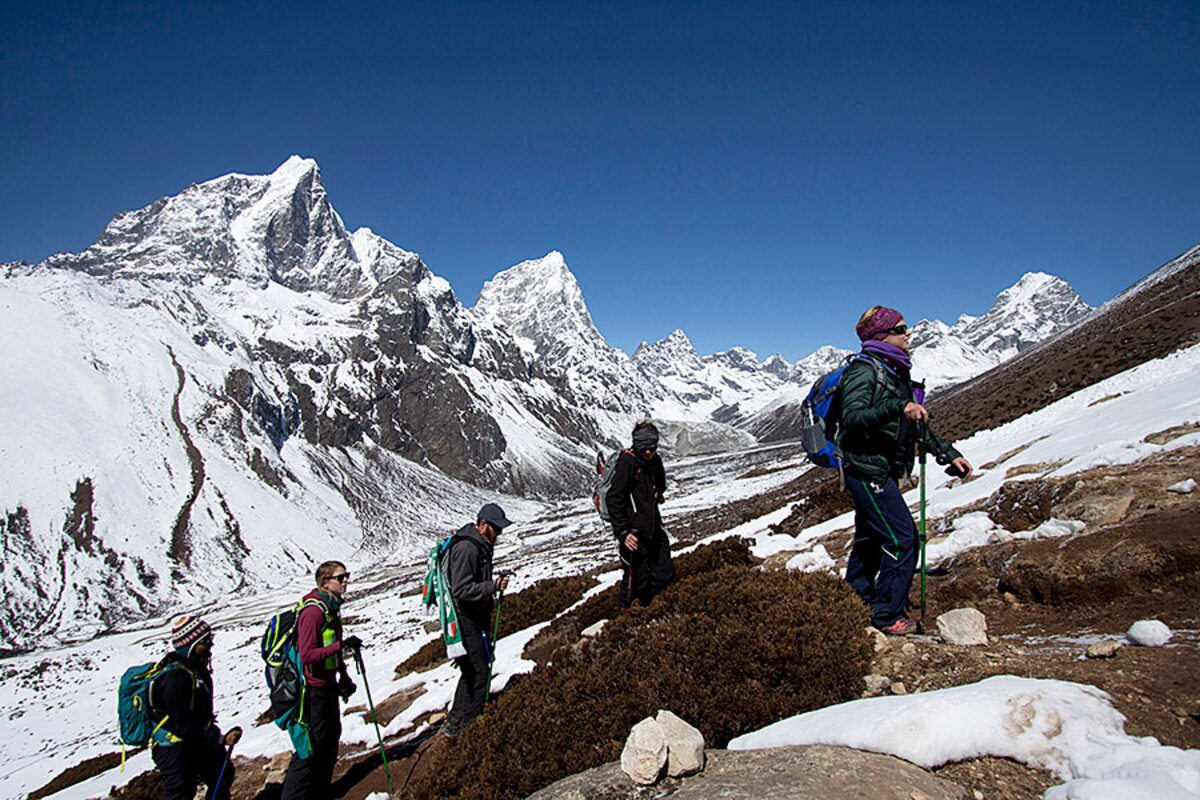Nepal may limit access to Mount Everest. A good idea?
Loading...
Nepal's government announced that it is considering restricting would-be climbers of Mount Everest based on their age, disability, and experience, a a decision that is being met with skepticism by the international mountaineering community.
Some veterans of the climb say that Everest is long overdue for regulation, but that the real issue is the government’s ability to enforce any regulation on the tour operators in a tiny market where clients are willing to shell out $60,000 for a summit experience.
Under proposed changes, the Ministry of Tourism would not allow anyone younger than 18 or older than 75, or those with disabilities to climb. There would also be more stringent checks on the level of an applicant’s previous mountaineering experience.
"We don't think we should issue permits to people who cannot see or walk or who don't have arms," tourism department chief Govinda Karki . Many blind and disabled climbers have reached Everest's summit.
Richard Salisbury with Himalayan Database says in an interview, “I do not know why Nepal is doing this at this time. The restrictions of prior experience seem reasonable, but probably not very practical to enforce since most climbers get their experience outside of Nepal.”
In 2013, 658 climbers reached the summit of Everest, according to the Himalayan Database.
In 2014, the mountain was closed after 16 Sherpa guides died in an accident. Earlier this year, an earthquake triggered an avalanche that killed 18 climbers, aborting the season.
��������������, age 70, says there says there is much more to the changes than safety concerns. Mr. Taylor, the founder of the in Franklin, West Va., grew up in the Himalayas, and has summited Everest on multiple occasions. He is the third generation of a family with a century of social service and conservation in the Himalaya.
“Three constituencies have come together, all of which have in common the overlap [limiting those climbing], but for very different reasons, to say, ‘We have too much on the mountain,” Taylor says in an interview. “For the Nepali commercial operators the economic factor is important. For the Nepalese government, the safety factor and public relations factor is important because they’ve come under criticism for allowing too many people onto the mountain. For the environmentalists, were putting too many people on the mountain.”
Nick Heil has climbed the lower slopes but never summited Everest and is the author of the 2008 book titled
He says in an interview, “How effective this will be on lowering the body count on Everest I really don’t know. I don’t see that it would be that effective. I think it’s a bit of posturing.”
“Also, I have a feeling if they do try to crack down on this there’s going to be a very strong push back from the disabled community,” Mr. Heil adds. “I was there [at Everest] on a climb and there was a guy with no legs who climbed Everest and did pretty well. I think there’s a strong feeling among the disabled community that they don’t want to be discriminated against.”
In his book Mr. Heil wrote about the May 15, 2006 death of David Sharp, a young British climber who, “lay dying near the top of Mount Everest while forty other climbers walked past him on their way to the summit.”
“The ministry of tourism in Nepal releases these kinds of statements every so often about restrictions or change of regulations. My overall reaction is that they’re posturing. Trying to give the public the impression that they’re more in control than they actually are,” Heil says. “The issue is enforcing it. Because, really, they have to go through the commercial operators who are up there. They’re the ones filling out the permit applications and who would be checking on the experience levels of climbers.”
Heil says that a more effective way to keep people safer on Everest would be “better communication between the operators.”
“I do think the operators should be screening for experience and if they don’t have the proper experience that they have a criteria for evaluating the safety of the client,” Heil concludes. “But it’s a big money game up there. So it’s very hard to walk away from a paying client if they think a client is even marginally legit. They’re all scrambling for the relatively small market of people willing to pay $40,000 to $60,000 to take them up the mountain.”
According to Gordon Janow, Director of Programs for Alpine Ascents International, in an interview, other major climbs are self-regulating in as much as, “[The world's second tallest mountain, Pakistan's] K2 is climbed so infrequently due to the technical nature that it does not need regulation – at least at this point.”
“Mountains in the US are by a concession system and quotas within that system. Europe has a reservation system for areas like Mt. Blanc and the Matterhorn,” according to Mr. Janow. “Nepal would be the first government to take on limit by skill level, a near impossible task (something I personally have to do on a daily basis) on a number of levels but certainly no issue from our end with the intent to control the volume of climbers. Just a poor and untenable method.”





